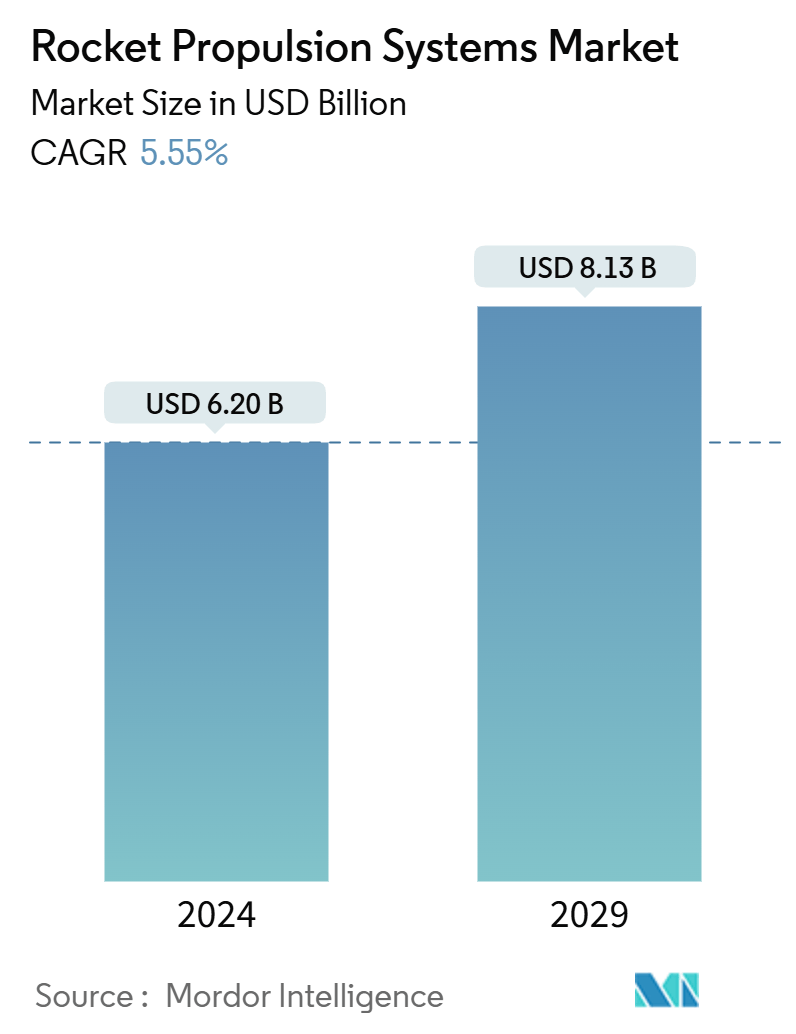Market Size of Rocket Propulsion Systems Industry

| Study Period | 2019 - 2029 |
| Market Size (2024) | USD 6.20 Billion |
| Market Size (2029) | USD 8.13 Billion |
| CAGR (2024 - 2029) | 5.55 % |
| Fastest Growing Market | Asia-Pacific |
| Largest Market | North America |
| Market Concentration | High |
Major Players
*Disclaimer: Major Players sorted in no particular order |
Rocket Propulsion Systems Market Analysis
The Rocket Propulsion Systems Market size is estimated at USD 6.20 billion in 2024, and is expected to reach USD 8.13 billion by 2029, at a CAGR of 5.55% during the forecast period (2024-2029).
Major global economies are increasing investments in space centers and satellite launches while emphasizing alternate fuels to reduce carbon footprints. These initiatives are pivotal in driving the space market's growth. Technological advancements are simultaneously reducing manufacturing costs and improving fuel efficiency. Recognizing the potential, government bodies provide substantial investments, especially in R&D, to major industry players. This backing not only encourages continuous innovation but also leads to the emergence of more advanced technologies.
However, the space industry's operational structure makes it uniquely vulnerable to economic shocks. Segments such as space exploration, satellite manufacturing, and scientific endeavors are characterized by specialized, low-volume production and often rely on a limited supplier base.
Despite these challenges, the space sector is experiencing a surge in entrepreneurial activities. This upswing is fueled by technological breakthroughs, increased access to space, and a rising tide of public and private investments. The sector offers abundant opportunities for innovative ventures, from satellite technology to space tourism and even asteroid mining. This wave of entrepreneurship is not only reshaping the industry but also setting the stage for a promising growth trajectory in the coming years.
Rocket Propulsion Systems Industry Segmentation
Rocket propulsion is a critical sub-system of a rocket that propels itself from the ground into the atmosphere. This study delves into the various rocket propulsion systems crucial for space launch vehicles.
The rocket propulsion systems market is segmented by type, end user, and geography. Based on type, the market is segmented into solid, liquid, and hybrid. By end user, the market is segmented into civil and commercial, and military. The report also covers the market sizes and forecasts for the rocket propulsion systems market across different regions. For each segment, the market size is provided in terms of value (USD).
| Type | |
| Solid | |
| Liquid | |
| Hybrid |
| End User | |
| Civil and Commercial | |
| Military |
| Geography | |
| North America | |
| Europe | |
| Asia-Pacific | |
| Rest of the World |
Rocket Propulsion Systems Market Size Summary
The rocket propulsion systems market is experiencing significant growth, driven by increased investments from major economies in space exploration and satellite launches. The industry is characterized by high levels of specialization and a limited number of suppliers, with many segments dominated by small and medium-sized enterprises. However, the COVID-19 pandemic has posed challenges, leading to industry concentration and impacting smaller firms reliant on larger contracts. The market's expansion is fueled by technological advancements aimed at reducing manufacturing costs and enhancing fuel efficiency, supported by government investments that enable continuous innovation. The competitive landscape is intense, with countries like the United States, China, and India heavily investing in space programs to achieve milestones in space exploration and develop new technologies.
In the Asia-Pacific region, countries such as China and India are making substantial investments in their space launch industries, with initiatives to develop indigenous capabilities and reduce reliance on foreign launches. The Indian Space Research Organisation, for example, is focused on building rockets to enhance communication satellite launches and broadband connectivity. Similarly, Japan is fostering private sector growth in the rocket propulsion market, supporting companies like Interstellar Technologies in their endeavors. The market is consolidated, with major players like Antrix Corporation Ltd, Safran SA, and Aerojet Rocketdyne forming partnerships with government agencies to advance space exploration capabilities. These companies are also investing in alternative fuel technologies and breakthrough innovations, such as plasma-powered rocket engines, to enhance the viability and speed of space exploration activities.
Rocket Propulsion Systems Market Size - Table of Contents
-
1. MARKET DYNAMICS
-
1.1 Market Overview
-
1.2 Market Drivers
-
1.3 Market Restraints
-
1.4 Industry Attractiveness - Porter's Five Forces Analysis
-
1.4.1 Bargaining Power of Suppliers
-
1.4.2 Bargaining Power of Buyers/Consumers
-
1.4.3 Threat of New Entrants
-
1.4.4 Threat of Substitute Products
-
1.4.5 Intensity of Competitive Rivalry
-
-
-
2. MARKET SEGMENTATION
-
2.1 Type
-
2.1.1 Solid
-
2.1.2 Liquid
-
2.1.3 Hybrid
-
-
2.2 End User
-
2.2.1 Civil and Commercial
-
2.2.2 Military
-
-
2.3 Geography
-
2.3.1 North America
-
2.3.2 Europe
-
2.3.3 Asia-Pacific
-
2.3.4 Rest of the World
-
-
Rocket Propulsion Systems Market Size FAQs
How big is the Rocket Propulsion Systems Market?
The Rocket Propulsion Systems Market size is expected to reach USD 6.20 billion in 2024 and grow at a CAGR of 5.55% to reach USD 8.13 billion by 2029.
What is the current Rocket Propulsion Systems Market size?
In 2024, the Rocket Propulsion Systems Market size is expected to reach USD 6.20 billion.

